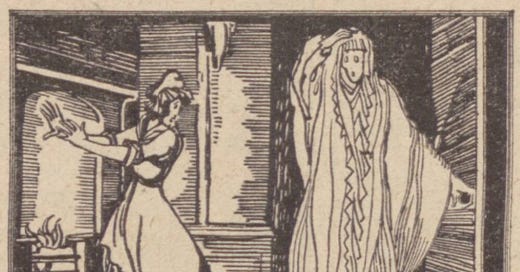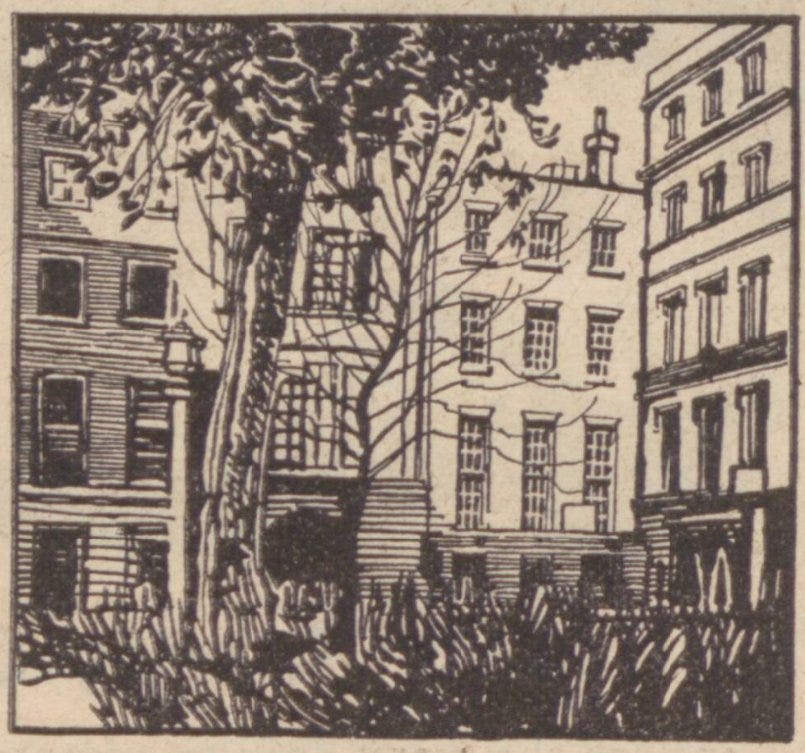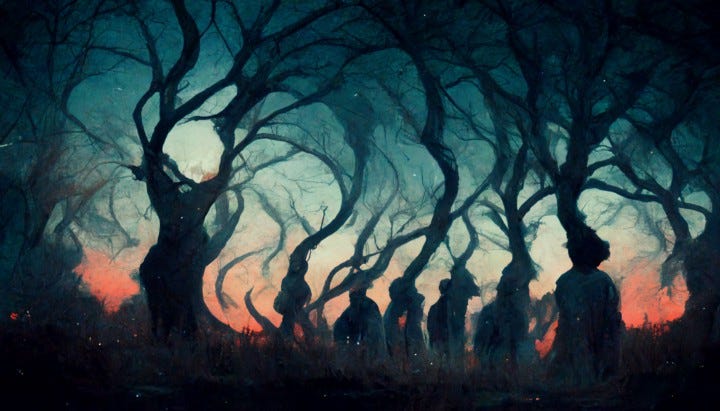In 1704, a man of very wealthy appearance moved into furnished lodgings in a house in London’s Soho Square. After a few weeks, the lodger — who gave his name as Mr Woodville — went to his live-in landlord with sad news. The lodger’s brother, who lived in Hampstead, had died. The brother had requested on his death bed to be buried in the family vault at Westminster Abbey. The lodger asked the landlord if he could bring his brother’s corpse to the house in order to make arrangements for the funeral. The landlord, without hesitation, agreed.
A “very handsome” coffin containing the brother’s body dressed in a white shroud was delivered by hearse and placed in the dining room. The funeral was to take place on the following day, and the landlord was advised that the lodger would be out until late making arrangements. The landlord and his family went to bed at around midnight. A maid was left downstairs to let the lodger in when he returned and to boil some water for tea.
The maid was sitting alone in the dimly-lit kitchen when she was startled by the opening of the dining room door. Then she saw a tall “spectre-looking” figure enter the kitchen and sit silently in the chair opposite. According to the story, told in an 1823 book of Ghost-Stories and in numerous newspapers, the maid reacted unsurprisingly:
“The maid was by no means one of the most timid of her sex; but she was terrified beyond expression, lonely as she was, at this unexpected apparition. Uttering a loud scream, she flew out like an arrow at a side door, and hurried to the chamber of her master and mistress.”
She woke the landlord and his wife, yelling, “A ghost! A ghost!” and tried to explain “some portion of the fright” that had overwhelmed her. “Oh, you fool,” said the landlord, “there's no such thing in nature. You have been asleep, woman, and waking suddenly have fancied you saw a thing there never was.” But just as the landlord had dismissed the maid’s story, the spectre entered the bed-chamber, “enveloped in a shroud, and with a face of death-like paleness”. Once again, as the maid, the landlord, and his wife looked on with horror, the spectre silently took a seat on a chair.
“The worst of all was that this chair stood by the door of the bed-chamber so that not a creature could get away without passing close to the apparition, which rolled its glaring eyes so frightfully, and so hideously distorted its features, that they could not bear to look at it.”
“The master and mistress crept under the bedclothes, covered with profuse perspiration, while the maid-servant sunk nearly insensible by the side of the bed. At the same time, the whole house seemed to be in uproar; for though they had covered themselves over head and ears, they could still hear the incessant noise and chatter, which served to increase their terror.”
“At length all became perfectly still in the house. The landlord ventured to raise his head, and to steal a glance at the chair by the door; but, behold, the ghost was gone! Sober reason began to resume its power. The poor girl was brought to herself after a good deal of shaking. In a short time, they plucked up suffient courage to quit the bedroom.”
From the violent noise they had heard, the landlord, his wife, and the maid expected to find the house to have been torn apart. And, in a way, their expectations were met. The house was in disorder, with every room ransacked. The maid suggested that they might have been robbed. But the landlord again dismissed her, saying, “Why, thou silly jade, can it be supposed that ghosts, or spirits, who have neither flesh, blood nor bones, can rob?” Within a few moments, he realised that she was right.
The entire house had been emptied of valuables — to the value of almost £600. The landlord rushed into the dining room and found an empty coffin. The spectre had not been a ghost but an “artful” thief. It was no surprise when the supposedly wealthy lodger never returned to pay his bill. It turned out he was a notorious criminal named Arthur Chambers. And he had played the roles of both Mr Woodville and his deceased brother.
“The supposed corpse was this arch-rogue himself, who had whitened his hands and face with chalk, and merely counterfeited death. About midnight, he quitted the coffin, and appeared to the maid in the kitchen. When she flew up the stairs, he softly followed her, and, seated at the door of the chamber, he acted as a sentinel, so that his industrious accomplices were enabled to plunder the house without the least molestation.”
According to the story, Arthur Chambers was executed at Tyburn in 1706. Records show this is true. Chambers, “a master of thieves’ slang, who was full of artful tricks”, was hanged at Tyburn on 1 January 1706. He is featured in the Newgate Calendar, an account of crimes and criminals published in various formats through the 1700s. That book describes him as “of base extraction, and consequently void of education, good manners or any other qualification that was amiable” and says he “committed actions the most daring and artful that were ever known”. Included among his crimes is an account of the Soho Square “ghost” robbery.
The story was colourfully revived in Ghost-Stories (Collected With a Particular View to Counteract the Vulgar Belief in Ghosts and Apparitions and to Promote a Rational Estimate of the Nature of Phenomena Commonly Considered as Supernatural), which was anonymously written, but “Printed for R. Ackerman” in 1823. The tale was excerpted in multiple newspapers following the publication of the book and retold for more than a century, most recently in 1937 in the Daily Mirror, from which the sketches above are taken.◆
It’s October, which has fully morphed from one night of kids wearing ghostly bedsheets and carving out turnip head lanterns into a full month of adults cosplaying as superheroes and decorating their homes with illuminated plastic pumpkins. That’s Halloween, the eve of the Western Christian feast of All Hallows’ Day, as faithfully celebrated with every purchase of a Starbucks pumpkin spice latte. Singular Discoveries has apparently gone pumpkin spice mad, hence the above sort-of ghost story and another haunted edition from the archive in just two weeks’ time.
Continuing the spooky theme, one of my most read online pieces continues to be The Strange But True Story of the Witches’ Circle, the tale of a mysterious ring of trees in an ancient Tyneside village. This was quite hastily written back in October 2012, meaning it’s now a full ten years old. To celebrate this debatable milestone, I’ve added some new artwork. As it’s Halloween, if you haven’t already, you can read it for free over at Medium.
In case you missed it, there was another ghost story in this newsletter’s Christmas edition (and, more recently, the creepy tale of Knocks from a Coffin).
Now some non-spooky recommendations:
Recommended:
From the Memoirs of a Private Detective by Dashiell Hammett (The Smart Set, March 1923)
Dashiell Hammett is best known as the author of hard-boiled fictional detective novels such as The Maltese Falcon and The Thin Man. He based his writings on his experiences as an actual detective with the famous Pinkerton Agency. He was first published in literary mag The Smart Set, and one of his earliest pieces was this 1923 list of often amusing memories. “The chief of police of a Southern city once gave me a description of a man, complete even to the mole on his neck, but neglected to mention that he had only one arm,” he writes. Also: “I know a man who once stole a Ferris wheel.” Whether real or imagined, it’s an entertaining read. You can find it reproduced here.
The Bizarre Mystery of the Only Armed Nuke America Ever Lost by Matthew Gault (Vice, 29 August 2022)
As Matthew Gault explains in this piece, the US has lost a lot of nuclear bombs over the years, six of them still unaccounted for. This one, lost in 1965 in the Philippine Sea about 70 miles off the coast of Japan, is armed. It was supposed to be carried into the air by US Navy Lieutenant Douglas Webster in an A-4E Skyhawk. Unfortunately, the loaded Skyhawk rolled off the USS Ticonderoga aircraft carrier before takeoff, sinking with its pilot and the armed nuke to the bottom of the sea. An apparently substantial search never located the plane, Webster, or the bomb. Only Webster’s helmet was ever found. Read the story over at Vice.
There’s now less than a month to go before the release of my new book, and queues of discerning readers are beginning to form outside all good bookshops.
The Tyne Bridge: An Icon of North-East England will be published on 3 November by Hurst. You can find more information and order it here.
The book is a celebration of one of Britain’s most iconic structures, recognised around the world by its unique silhouette. It uncovers the forgotten histories of the Tyne Bridge's predecessors, from the Roman Pons Aelius and the amazing medieval Old Tyne Bridge through to the Victorian era as Tyneside became a famous place of bridges. It tells the untold stories of the men (and woman) who designed and built the Tyne Bridge in difficult and dangerous circumstances, from the pressurised depths of the foundations to the perilous heights of the steel arch. And it discovers how the bridge became a symbol of Tyneside, an emblem of the region’s cultural identity, and a monument to the Tyne’s industrial past.
As its 100th anniversary approaches, what makes the Tyne Bridge the greatest bridge in the world? Expect lots of unusual stories of the type that fill this newsletter. And lots of photos, some old, some new, some famous, and some rare archive shots specially restored for the book. Diagrams, too. And a map…
I’ll be talking about the book at the Books on Tyne Newcastle Book Festival on 22 Nov. Get free tickets here.
That’s all for now. More in two weeks, some say a fortnight. Do the right thing and share / subscribe. Ta.
Enjoy the read? Reward the writer.
This newsletter is published ad-free, subscription-free, and outside of any paywall. We hope you enjoy it. We believe writers deserve fair payment for quality content. We ask every reader to consider tipping the cost of a cup of coffee for this newsletter. All Ko-fi payments go directly to the writer. Thank you for your support. Click to tip.










